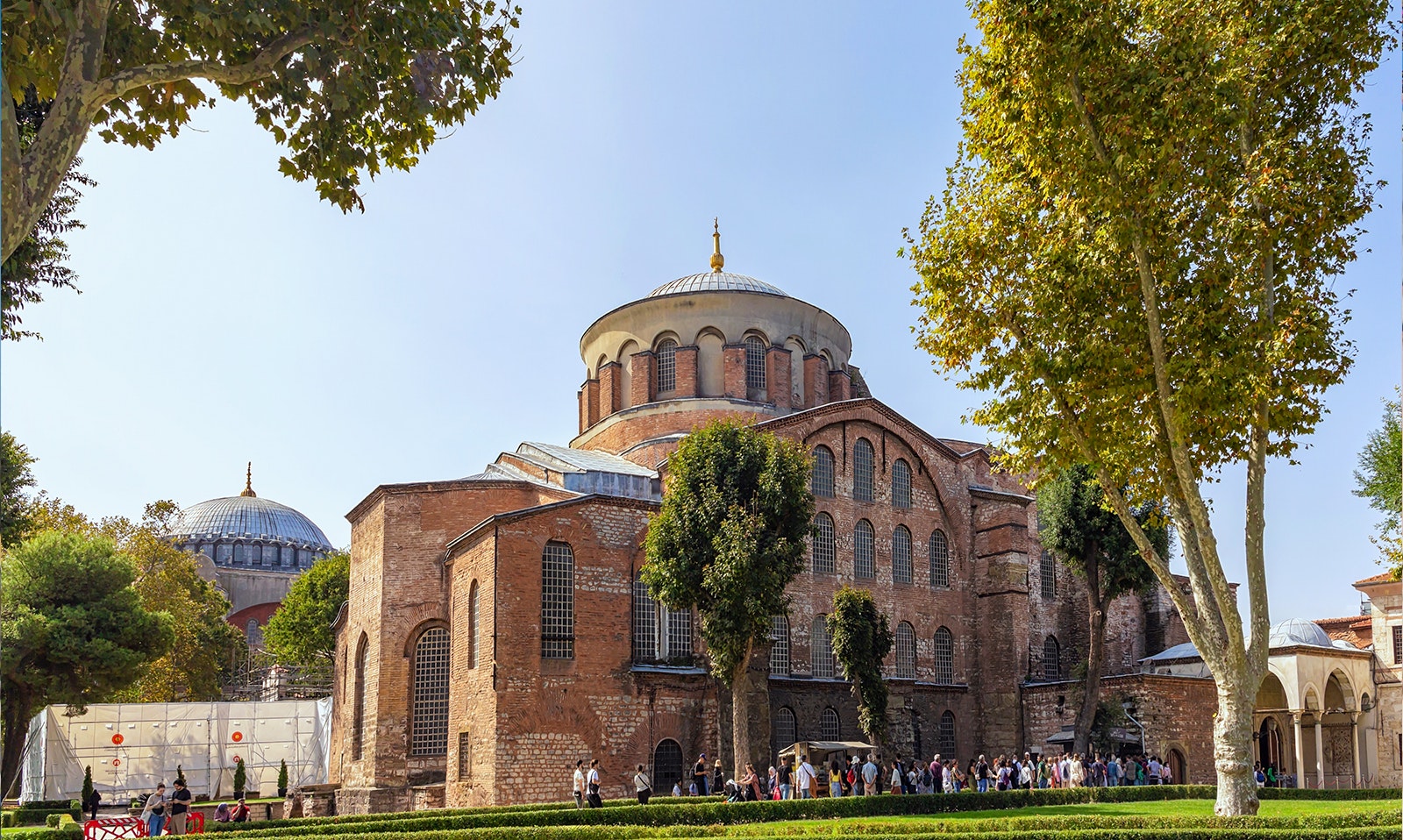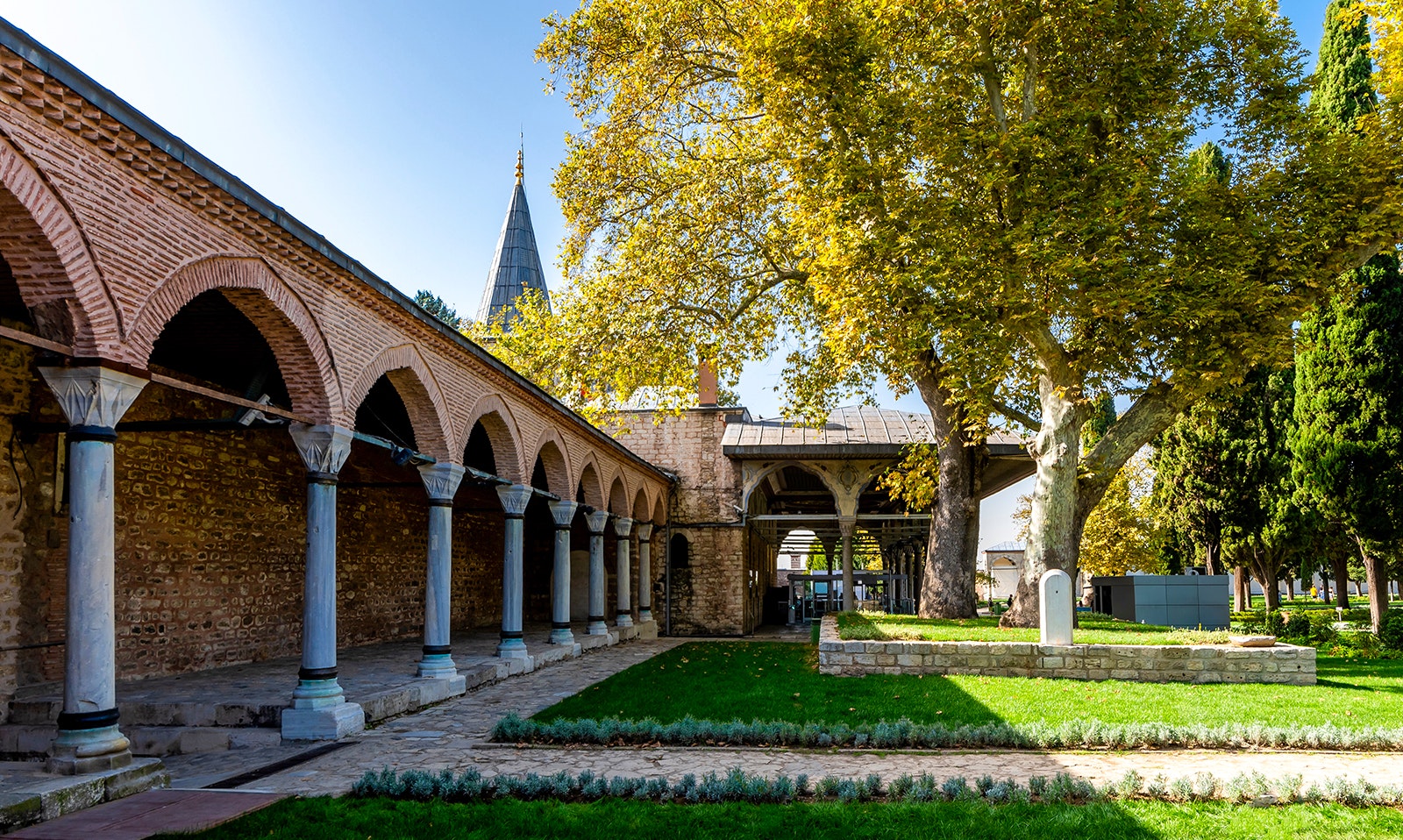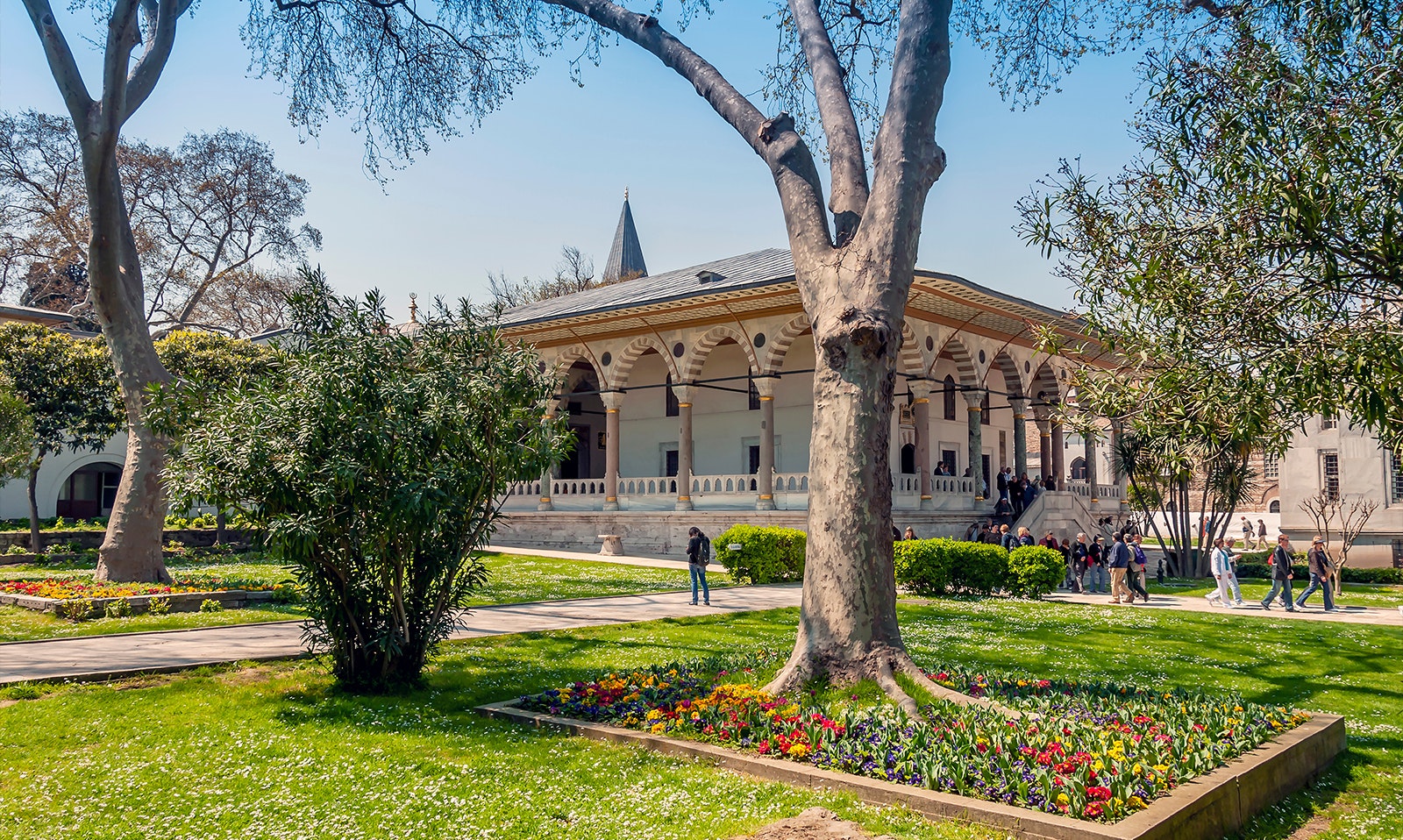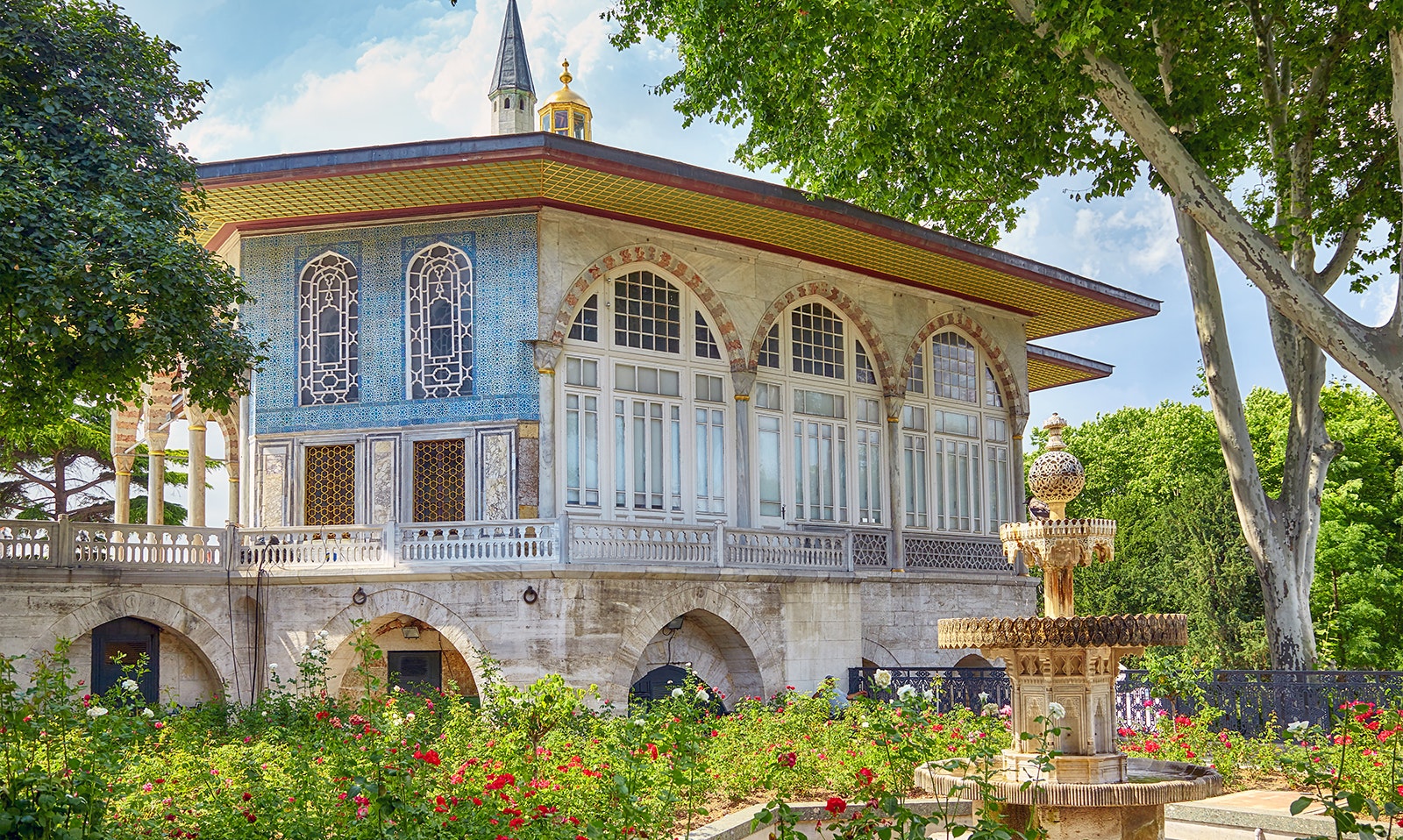Topkapi Palace, located in Istanbul, is a must-visit for anyone interested in the history and culture of the Ottoman Empire. Before moving to Dolmabahçe Palace in 1853, it served as the empire's heart, home to its sultans and their harem for nearly 300 years. This palace, now a major attraction, offers a glimpse into the Ottoman era's splendor. The complex features elaborate courtyards, lush gardens, beautiful mosaics, art, and lavish decorations, offering a panoramic view of Istanbul.
As a historical and museum site, Topkapi Palace showcases extensive Ottoman artifacts and manuscripts. Its four magnificent courtyards highlight Ottoman architectural achievements and history. Continue reading to explore the treasures and stories of this iconic palace.
Recommended tickets to Topkapi Palace
Inside Topkapi Palace: Top highlights
Topkapi Palace, the Ottoman Sultans' home and office, spans 7.5 million square feet. It features four main courtyards, each enclosed by tall walls and serving distinct functions. The courtyards are separated by gates, with access becoming more restricted as one progresses to the third and fourth courtyards, the most private areas. The palace mostly comprises one- or two-story buildings, which have served various purposes throughout history. Due to these changes in function, especially in the harem section, the original use of some buildings remains unclear.
Topkapi Palace - First Courtyard
The First Courtyard of Topkapi Palace, also known as the Janissaries Court or the Parade Court, is the largest. Enclosed by tall walls, it served as an external area or park. This courtyard was where the janissaries, elite soldiers, and court officials would assemble, presenting a well-organized appearance.

1. Fountains
Among various fountains, the Executioner's Fountain is notable. It's named after the legend that the executioner would wash his hands here post-execution.
2. Hagia Irene
This is the oldest Christian Orthodox church in Istanbul, established in the 4th century, predating Hagia Sophia by 200 years. In Ottoman times, it was used as an arsenal and warehouse. Now a museum, it hosts classical music events, taking advantage of its excellent acoustics. Access to the church requires a separate ticket.
3. The Garden
As you enter the First Courtyard, you're greeted by the palace's serene gardens, perfect for a relaxing walk.
Topkapi Palace - Second Courtyard
The Second Courtyard, or Divan Square, is accessed through the Middle Gate. Surrounding it are the palace's kitchens on the left and confectionery shops on the right, creating a park-like setting.

1. Harem
More than a place for the Sultan's private life, the Harem was central to the Ottoman dynasty's continuity, housing several hundred women. Its architecture, spanning the 16th to early 19th centuries, is historically significant.
2. Palace Kitchens
Positioned on the right side of the courtyard, these kitchens once served the royal family and numerous palace staff. Today, they exhibit Ottoman culinary tools and a vast array of Chinese porcelain.
3. Porcelain Collection
Besides kitchen utensils, there is a collection of silver gifts and a vast array of porcelain. These porcelain pieces, often received from China during tributary visits, highlight the Ottoman's rich diplomatic exchanges.
4. Imperial Council Chamber
Located at the second courtyard's edge, this three-story building was where the imperial council met regularly to govern the empire. Adjacent to it is a room displaying the palace's collection of clocks.
5. Arms Collection
Topkapi Palace boasts an extensive Islamic arms collection, one of the largest globally, with pieces dating back to the 7th century. While primarily featuring Ottoman weapons, it also includes items from the Umayyad and Abbasid periods.
6. Tower of Justice
Situated on the left, this tower is notable for a secret room that allowed the Sultan to discreetly listen to council meetings.
7. Gate of Felicity
This gate marks the entrance to the Inner Court, with its dome supported by lean marble pillars, signifying the Sultan's presence. Entry was strictly controlled, and only permitted with the Sultan’s consent or under specific conditions for the Grand Vizier.
Topkapi Palace - Third Courtyard
The Third Courtyard once housed the private apartment of the Sultan until the 16th century when it was moved to the Harem. Significant Islamic relics, including the mantle, sword, and bow of the Prophet Mohammad, are housed in the Chamber of Holy Relics. The Dormitory of Privy Chambers is adorned with portraits of past Sultans, while the Dormitory of Campaigners exhibits Ottoman-era clothing. This courtyard showcases the immense wealth of the Ottoman Empire at its peak.

1. Miniature and Portrait Gallery
Located in the former pages' dormitory near the Imperial Treasury, this gallery displays significant calligraphy and miniatures. Highlights include valuable Qurans from the 12th to 17th centuries and a 4th-century Arabic Bible. It also houses Piri Reis's world map, showing early mapping of Europe, North Africa, and Brazil.
2. Enderûn Library (Library of Sultan Ahmed III)
An 18th-century Neo-classical building with marble cladding and a unique drinking fountain. It has a special reading corner for the Sultan and stores books on theology, Islamic law, and scholarship, protected from moisture in a specially designed low basement.
3. Mosque of the Ağas
This is the largest mosque within the palace, dating back to the 15th century. It became the Palace Library in 1928, housing around 13,500 books and manuscripts, including the Enderûn Library collection. The Imperial Portraits Collection is located on its northeast side.
4. Audience Chamber
A 16th-century pavilion where the Sultan met with officials and foreign ambassadors. Notably, it has faucets that were used to prevent eavesdropping during discussions.
5. Dormitory of the Expeditionary Force
An 18th-century building showcasing the Sultan's luxurious clothing collection, including imperial robes and caftans embroidered with silver and gold.
6. Sacred Safekeeping Rooms
Features significant Islamic relics, like the Prophet Muhammad’s hair, tooth, and footprints, as well as items like Moses' staff and Joseph's robe, set against a backdrop of Iznik tiles.
7. Imperial Treasury
Located in the 15th-century Conqueror's Pavilion, it displays valuable jewels, heirlooms, and the renowned Topkapi Dagger and Spoonmaker's Diamond.
8. The Piri Reis World Map
Showcases the famous 16th-century map by Piri Reis, notable for its depiction of an ice-free Antarctica, a mystery given its creation centuries before Antarctica was officially discovered. Added to UNESCO’s Memory of the World Register in 2017.
Topkapi Palace - Fourth Courtyard
The fourth courtyard of Topkapi Palace, accessible from the third, features landscaped gardens and leisure pavilions. Notable within this courtyard is the Iftariye Kameriyesi, an ornate gilt-bronze Iftar pergola where the Sultans would break their Ramadan fast. Surrounding this area are several other pavilions, including the Circumcision Chamber, Yerevan Pavilion, and Baghdad Pavilion, each adding to the grandeur of the palace's final courtyard.

1. Circumcision Room
Built by Sultan Ibrahim I in 1640, this summer kiosk for circumcising young princes features blue tile decorations with floral designs, symmetric proportions, and windows with small fountains.
2. Yerevan Kiosk
Used for 40-day religious retreats, it has a central dome, sofa-lined apses, a fireplace, and a mix of marble and İznik tiled walls, reflecting earlier tile patterns.
3. Baghdad Kiosk
Erected to celebrate Murad IV's Baghdad campaign in 1638, it mirrors the Yerevan Kiosk with a marble façade, porphyry strips, and interiors epitomizing Ottoman design.
4. Iftar Kiosk
Known for its Golden Horn view, this gilded pavilion features a unique ridged cradle vault and was used by the Sultan for breaking fast during Ramadan.
5. Terrace Kiosk
Originally a 16th-century belvedere, it was remodeled in the Rococo style by Mahmud I in 1752, serving various purposes over time, including as a guest lodge and viewing platform for events.
6. Chamber of the Chief Physician
Formerly the royal physician's treatment area, now housing a display of historical pharmaceutical tools and equipment.
7. Grand Kiosk
Constructed in 1840 as an imperial reception and resting area, offering expansive views of the Sea of Marmara and the Bosphorus, used by Sultans during palace visits.
8. Terrace Mosque
Built in the Empire style in the 19th century by Mahmud II for the Sofa Ocaği corps, later restored in 1858 by Sultan Abdülmecid I.
9. Outer Terrace
Offers panoramic views of Istanbul, the Golden Horn, and the Sea of Marmara from the Fourth Courtyard's lower level terrace.


